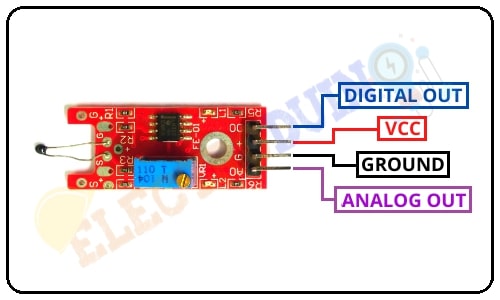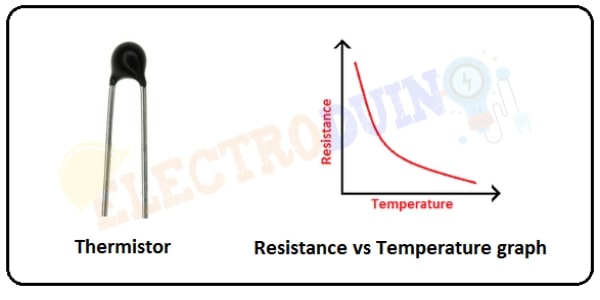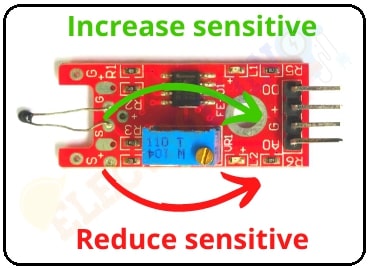Thermistor Thermal Temperature Sensor | How it’s Works
Hello friends! Welcome back to ElectroDuino. This blog is based on Thermistor Thermal Temperature Sensor | How it’s Works. Here we will discuss the Introduction to Thermistor Thermal Temperature Sensor, Pin Diagram, Module Hardware Overview, Working Principle, its Specifications, and Applications.
Introduction
Thermistor Thermal Temperature Sensor is consists of an NTC thermistor that measures temperature changes. This module is able to provide both digital and analog outputs. NTC thermistor is a variable resistor that’s resistance value changes according to change of temperature. The word of NTC means Negative Temperature Coefficient. The sensitivity of the module will be change by the onboard potentiometer.
Thermistor Thermal Temperature Sensor Module Pin Diagram

| Pin Number | Pin Name | Description |
| 1 | Digital output (DO) | Digital Output (0 or 1) |
| 2 | VCC (+) | +5 v power supply |
| 3 | Ground (GND) | Ground (-) power supply |
| 4 | Analog output (AO) | Analog output (0 or 1023) |
Temperature Sensor Module Hardware Overview
The Thermistor Thermal Temperature sensor module consists mainly of the NTC Thermistor, LM393 Comparators, Variable Resistor (Trimmer), Power LED, output LED.

1. NTC Thermistor
The thermistor is one type of variable resistor whose resistance change according to the change in temperature. There are two types of temperature available one is the negative temperature coefficient(NTC) and another one is the positive temperature coefficient(PTC). This module is consists of the 10K negative temperature coefficient(NTC) thermistor. Whose, resistance is increase when the temperature is decreased and it’s resistance is decreased when the temperature is increased.

2. Variable Resistor (Trimmer)
This Sensor has an onboard 10k ohm variable resistor(potentiometer). Rotate the Trimmer knob to adjust the sensitivity of Temperature detection of the Sensor. If the preset knob rotated clockwise, the sensor sensitivity will be increased. If it rotated counterclockwise, the sensor sensitivity will be decreased.

3. Power LED
This LED indicates the sensor power supply is ON or OFF. When we connect the sensor to the power supply this RED LED is also turn on.
4. Output LED
When the sensor detects the fire flame or ambient temperature, the RED LED is turn on. When it does not detect any fire flame or ambient temperature, the RED LED is turn off.
How Thermistor Thermal Temperature Sensor Module Works
At first, we need to connect the temperature sensor module to the 5v power supply. Then set the threshold voltage according to the normal temperature of the environment by rotating the preset knob for setting the sensor sensitivity.

When temperature increase around the thermistor then the resistance of the thermistor decreases and increases the conductivity of the element. So, a high amount of voltage goes to the LM393 comparator. Then the LM393 compares this voltage with the threshold voltage. If this voltage reaches the threshold voltage then the temperature sensor output goes Low (0).
In contrast, When temperature increase around the thermistor then the resistance of the thermistor increases and decreases the conductivity of the element. So, a low amount of voltage goes to the LM393 comparator. Again the LM393 compares this voltage with the threshold voltage. But, now this voltage is less than the threshold voltage. So, the temperature sensor output becomes High (1).
Sensor Specifications
| Parameter | Value |
| Range of Operating Voltage | 3.3V – 5V |
| Operating Current | 15 mA |
| Comparator chip | LM393 |
| Sensor type | NTC Thermistor |
| Sensitivity | Adjustable via Trimmer |
| Output type | Digital (0 or 1) and Analog output (0 to 1023) |
| LED lights indicators | Power (red) and Output (red) |
| Detection angle | 0 – 60 degree |
| Measurement range | -55 to +125°C |
| PCB Size | 36mm x 15mm |
Application
- It can detect the ambient temperature
- detect the temperature of the surrounding environment
- Fire detection and Fire alarm




